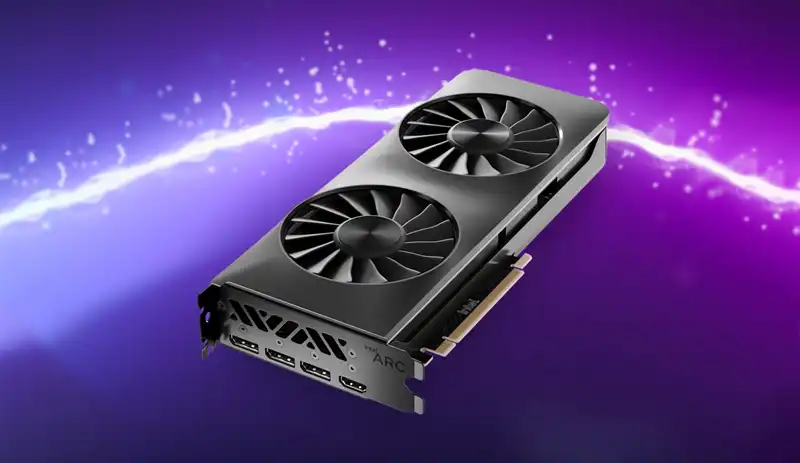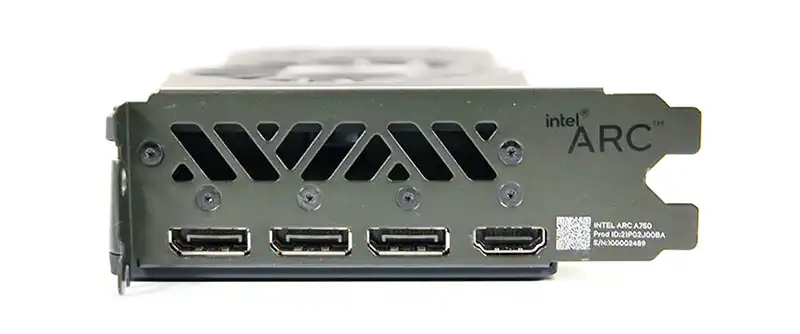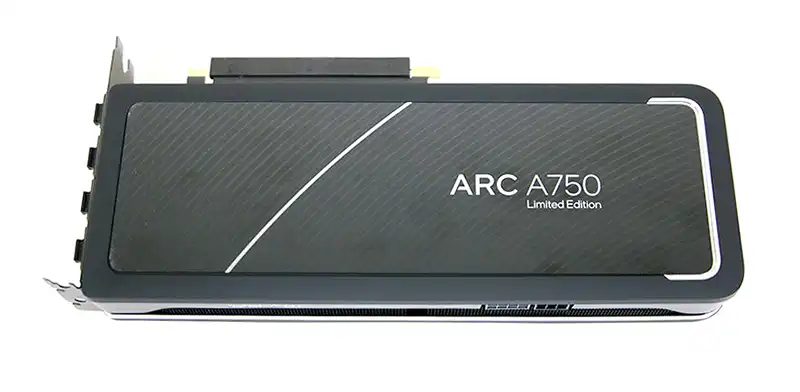You can also be interested in these:
Intel’s re-entry into the gaming GPU market with the Alchemist Xe HPG architecture has been highly anticipated. The Intel Arc A750 is the latest addition to the Alchemist lineup and is a cut-down version of the A770, with 8GB GDDR6 RAM and 4 Xe Cores and RT Units. However, it retains the same TBP of 225W and includes an AV1 encoder. This makes it a mid-range to low-end card for 1080p resolution gaming. The crucial question is how it performs compared to its higher-end counterpart.
Exterior design
Design-wise, the A750 follows the same design language as the A770, with an elegant and sleek design. The only custom models available are from ASRock and Acer. The A750 is 270mm long and 100mm wide, occupying two slots on the motherboard. Notably, the A750 lacks the RGB lighting found on the A770.

Moving on to the exterior design, the Intel Arc A750 GPU features two 90mm axial fans on a matte black metal cover. The fans have 15 blades for high airflow and produce only 39 dB of noise. The side panels have a partially closed design, leaving just enough room to expel hot air. The backplate completely covers the PCB and includes the product’s identification in white letters on diagonal lines. The power headers are integrated seamlessly into the card’s shroud, which also features the Intel ARC logo in white light. There are no visible screws, indicating that the cover is challenging to remove.
The A750 is a mid-range graphics card that should offer decent performance at 1080p resolution. It has an elegant and sleek design, although it lacks RGB lighting. It remains to be seen how it performs compared to its higher-end counterpart, the A770. Nonetheless, the A750 is a welcome addition to the gaming GPU market, and we look forward to seeing how it performs in real-world applications.
Ports and connectivity
The Intel Arc A750 graphics card boasts an impressive set of ports that match its higher-end counterpart. The card features a total of four video outputs, including one HDMI 2.1 port and three DisplayPort 1.4a ports. While it would have been ideal to have two HDMI ports instead of three DisplayPorts, the latter still provides impressive performance that makes up for the lack of HDMI options.

The HDMI 2.1 port can support uncompressed 4K video at up to 144 Hz, as well as 8K video at both 60 Hz and 120 Hz when using DSC. The graphics card is also designed with a power consumption of 225 watts TBP, with two PCI headers for power input – one with eight pins and the other with six pins. This provides ample power to support the PCIe 4.0 x16 communication interface, which allows the card to utilize the full capacity of the slot, similar to the A770.
PCB and heatsinks
While the A750 is a complex piece of technology, we can still dissect a few of its internal components. One notable feature of the A750 is its aluminum heatsink, which is densely finned and extends from one end to the other. The cold plate responsible for cooling the CPU and memory is made of a copper block with vapor chamber technology and several heatpipes to distribute heat throughout the useful area.
The PCB of the A750 contains the chipset in the central area, surrounded by 8 GDDR6 chips of 1 GB each, which use silicone thermal pads to transfer heat to the block. The power supply is provided by a VRM composed of 6+2 phases consisting of Monolithic MP86956 DrMOS MOSFETs of 70A and metal chokes.
Intel Arc A750 architecture
The A750 is powered by the Alchemist Xe HPG architecture, which is similar to the A770 but with 4 fewer computing units and a significant reduction in VRAM. The Alchemist Xe HPG architecture is based on a 6nm manufacturing process built by TSMC and marks a new era of competitiveness for Intel in laptops and other new generations.
The A750 has 8 rendering segments, with one disabled, making a total of 7 usable segments. Each of these segments has 4 Xe cores, for a total of 28 units, which are comparable to Nvidia’s SM. However, the internal architecture becomes more complex, with each Xe core divided into 4 simpler functional units. There are 16 Intel Xe Matrix Extensions Engines (XMX) of 1024 bits each for a total of 448 units (512 in the A770), responsible for working with XeSS (Xe Super Sampling) technology and AI, 16 Xe Vector Engines (XVE) of 256 bits each (448 units in total), responsible for traditional rasterization tasks, 28 RT Core units for Ray Tracing (1 per Xe Core), and a total of 3584 Shaders. Each Xe Vector Engine has an FP execution port for shading tasks and an INT/EM port for integer operations.

Intel has released a new graphics card, the Intel Arc A750, which features a slightly modified clock frequency and a Total Board Power (TBP) of 225W, just like its predecessor, the A770. However, the A750 falls short in terms of performance per watt when compared to AMD and Nvidia’s latest generation graphics cards.
The A750 is Intel’s first architecture to offer hardware ray tracing, allowing users to play games with engines that integrate this technology. The ray tracing processing cores have proven to be highly effective, performing as well as Nvidia’s Ampere cores and even better than the RDNA 2 cores. Additionally, the A750 incorporates an AV1 encoder, which provides better video quality than H.264/265 and beats AMD RDNA 3 and Nvidia Ada Lovelace.
Final words about the Intel Arc A750 graphics card
The A750 features 8GB GDDR6 memory with a clock frequency of 2000 MHz and a 256-bit bus, generating a total bandwidth of 512 GB/s, just like the A770. However, the A770 has 16GB of VRAM, which is more suitable for rendering, video editing, and gaming in high resolutions.
Overall, the A750 offers a better performance-to-price ratio for gaming at 1080p, but the A770 is the better choice for tasks that require more VRAM. Both cards have an AV1 encoder and a double-fan cooler that performs well without making excessive noise.
